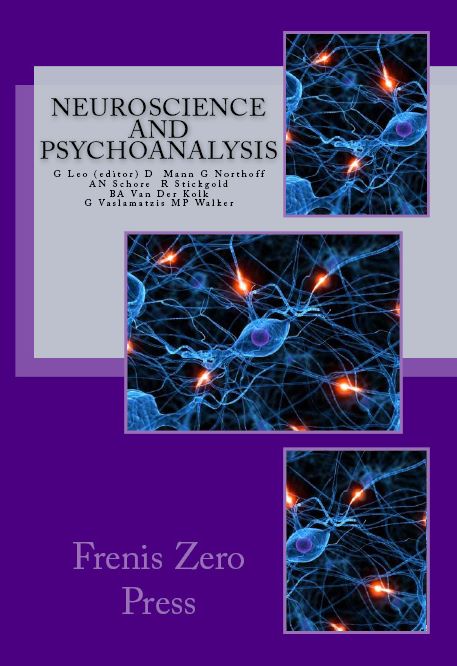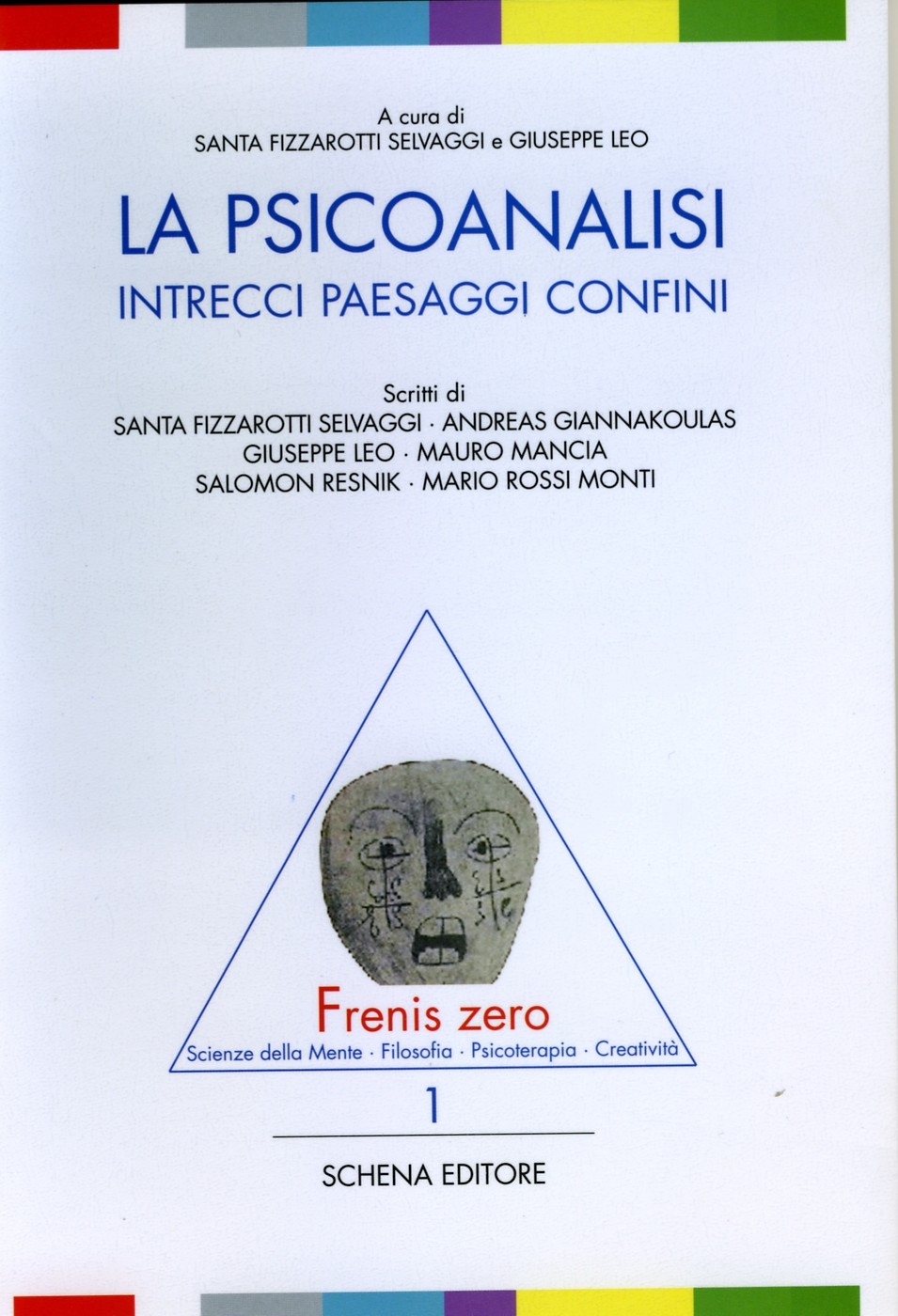|
A.S.S.E.Psi.
web site (History of Psychiatry and Psychoanalytic Psychotherapy
)
A.S.S.E.Psi.NEWS
(to subscribe our monthly newsletter)
Ce.Psi.Di. (Centro
di Psicoterapia Dinamica "Mauro Mancia")
Maitres
à dispenser (Our reviews about psychoanalytic congresses)
Biblio
Reviews (Recensioni)
Congressi
ECM (in italian)
Events
(our congresses)
Tatiana Rosenthal
and ... other 'psycho-suiciders'
Thalassa.
Portolano of Psychoanalysis
PsychoWitz - Psychoanalysis and Humor (...per ridere un po'!)
Giuseppe Leo's Art
Gallery
Spazio
Rosenthal (femininity and psychoanalysis)
Psicoanalisi
Europea Video
Channel
A.S.S.E.Psi. Video
Channel
Ultima uscita/New issue:

"Psicoanalisi, luoghi della resilienza
ed immigrazione"
Edited
by/a cura di:
Giuseppe Leo
Writings by/scritti di:
S.
Araùjo Cabral, L.
Curone,
M. Francesconi,
L.
Frattini,
S.
Impagliazzo,
D. Centenaro Levandowski, G. Magnani, M. Manetti, C. Marangio,
G. A. Marra e Rosa, M. Martelli, M. R. Moro,
R. K. Papadopoulos, A. Pellicciari,
G. Rigon,
D.
Scotto di Fasano,
E. Zini, A. Zunino
Editore/Publisher: Edizioni Frenis Zero
Collection/Collana: Mediterranean
Id-entities
Anno/Year:
2017
Pagine/Pages:
372
ISBN:978-88-97479-11-6

"Psicoanalisi in Terra Santa"
Edited
by/a cura di: Ambra Cusin & Giuseppe Leo
Prefaced by/prefazione
di:
Anna Sabatini Scalmati
Writings by/scritti di:
H. Abramovitch A. Cusin M. Dwairy A. Lotem M.
Mansur M. P. Salatiello Afterword
by/ Postfazione
di:
Ch. U. Schminck-Gustavus
Notes by/ Note di: Nader Akkad
Editore/Publisher: Edizioni Frenis Zero
Collection/Collana: Mediterranean
Id-entities
Anno/Year:
2017
Pagine/Pages:
170
ISBN:978-88-97479-12-3

"Essere bambini a Gaza. Il trauma
infinito"
Authored
by/autore: Maria Patrizia Salatiello
Editore/Publisher: Edizioni Frenis Zero
Collection/Collana: Mediterranean
Id-entities
Anno/Year:
2016
Pagine/Pages:
242
ISBN:978-88-97479-08-6

Psychoanalysis,
Collective Traumas and Memory Places (English Edition)
Edited
by/a cura di: Giuseppe Leo Prefaced by/prefazione
di:
R.D.Hinshelwood
Writings by/scritti di: J. Altounian
W. Bohleber J. Deutsch
H. Halberstadt-Freud Y. Gampel
N. Janigro R.K. Papadopoulos
M. Ritter S. Varvin H.-J. Wirth
Editore/Publisher: Edizioni Frenis Zero
Collection/Collana: Mediterranean
Id-entities
Anno/Year:
2015
Pagine/Pages:
330
ISBN:978-88-97479-09-3

"L'uomo
dietro al lettino" di
Gabriele Cassullo
Prefaced
by/prefazione di: Jeremy
Holmes
Editore/Publisher: Edizioni Frenis Zero
Collection/Collana: Biografie
dell'Inconscio
Anno/Year:
2015
Pagine/Pages:
350
ISBN:978-88-97479-07-9
Prezzo/Price:
€ 29,00
Click
here to order the book
(per Edizione
rilegata- Hardcover clicca qui)

"Neuroscience
and Psychoanalysis" (English Edition)
Edited by/a cura di: Giuseppe Leo Prefaced by/prefazione
di: Georg Northoff
Writings by/scritti di: D. Mann
A. N. Schore R. Stickgold
B.A. Van Der Kolk G. Vaslamatzis M.P. Walker
Editore/Publisher: Edizioni Frenis Zero
Collection/Collana: Psicoanalisi e neuroscienze
Anno/Year: 2014
Pagine/Pages: 300
ISBN:978-88-97479-06-2
Prezzo/Price: € 49,00
Click
here to order the book

Vera
Schmidt, "Scritti su psicoanalisi infantile ed
educazione"
Edited by/a cura di: Giuseppe Leo Prefaced by/prefazione
di: Alberto Angelini
Introduced by/introduzione di: Vlasta Polojaz
Afterword by/post-fazione di: Rita Corsa
Editore/Publisher: Edizioni Frenis Zero
Collana: Biografie dell'Inconscio
Anno/Year: 2014
Pagine/Pages: 248
ISBN:978-88-97479-05-5
Prezzo/Price: € 29,00
Click
here to order the book

Resnik,
S. et al. (a cura di Monica Ferri), "L'ascolto dei
sensi e dei luoghi nella relazione terapeutica"
Writings by:A.
Ambrosini, A. Bimbi, M. Ferri, G.
Gabbriellini, A. Luperini, S. Resnik,
S. Rodighiero, R. Tancredi, A. Taquini Resnik,
G. Trippi
Editore/Publisher: Edizioni Frenis Zero
Collana: Confini della Psicoanalisi
Anno/Year: 2013
Pagine/Pages: 156
ISBN:978-88-97479-04-8
Prezzo/Price: € 37,00
Click
here to order the book
Silvio
G. Cusin, "Sessualità e conoscenza"

A cura di/Edited by: A. Cusin & G. Leo
Editore/Publisher: Edizioni Frenis Zero
Collana/Collection: Biografie dell'Inconscio
Anno/Year: 2013
Pagine/Pages: 476
ISBN: 978-88-97479-03-1
Prezzo/Price:
€ 39,00
Click
here to order the book
AA.VV.,
"Psicoanalisi e luoghi della riabilitazione", a cura
di G. Leo e G. Riefolo (Editors)

A cura di/Edited by: G. Leo & G. Riefolo
Editore/Publisher: Edizioni Frenis Zero
Collana/Collection: Id-entità mediterranee
Anno/Year: 2013
Pagine/Pages: 426
ISBN: 978-88-903710-9-7
Prezzo/Price:
€ 39,00
Click
here to order the book
AA.VV.,
"Scrittura e memoria", a cura di R. Bolletti (Editor)

Writings by: J.
Altounian, S. Amati Sas, A. Arslan, R. Bolletti, P. De
Silvestris, M. Morello, A. Sabatini Scalmati.
Editore/Publisher: Edizioni Frenis Zero
Collana: Cordoglio e pregiudizio
Anno/Year: 2012
Pagine/Pages: 136
ISBN: 978-88-903710-7-3
Prezzo/Price: € 23,00
Click
here to order the book
AA.VV., "Lo
spazio velato. Femminile e discorso
psicoanalitico"
a cura di G. Leo e L. Montani (Editors)

Writings by: A.
Cusin, J. Kristeva, A. Loncan, S. Marino, B.
Massimilla, L. Montani, A. Nunziante Cesaro, S.
Parrello, M. Sommantico, G. Stanziano, L.
Tarantini, A. Zurolo.
Editore/Publisher: Edizioni Frenis Zero
Collana: Confini della psicoanalisi
Anno/Year: 2012
Pagine/Pages: 382
ISBN: 978-88-903710-6-6
Prezzo/Price: € 39,00
Click
here to order the book
AA.VV., Psychoanalysis
and its Borders, a cura di
G. Leo (Editor)

Writings by: J. Altounian, P.
Fonagy, G.O. Gabbard, J.S. Grotstein, R.D. Hinshelwood, J.P.
Jimenez, O.F. Kernberg, S. Resnik.
Editore/Publisher: Edizioni Frenis Zero
Collana/Collection: Borders of Psychoanalysis
Anno/Year: 2012
Pagine/Pages: 348
ISBN: 978-88-974790-2-4
Prezzo/Price: € 19,00
Click
here to order the book
AA.VV.,
"Psicoanalisi e luoghi della negazione", a cura di A.
Cusin e G. Leo

Writings by:J.
Altounian, S. Amati Sas, M. e M. Avakian, W. A.
Cusin, N. Janigro, G. Leo, B. E. Litowitz, S. Resnik, A.
Sabatini Scalmati, G. Schneider, M. Šebek,
F. Sironi, L. Tarantini.
Editore/Publisher: Edizioni Frenis Zero
Collana/Collection: Id-entità mediterranee
Anno/Year: 2011
Pagine/Pages: 400
ISBN: 978-88-903710-4-2
Prezzo/Price: € 38,00
Click
here to order the book
"The Voyage Out" by Virginia
Woolf

Editore/Publisher: Edizioni Frenis Zero
ISBN: 978-88-97479-01-7
Anno/Year: 2011
Pages: 672
Prezzo/Price: € 25,00
Click
here to order the book
"Psicologia
dell'antisemitismo" di Imre Hermann

Author:Imre Hermann
Editore/Publisher: Edizioni Frenis Zero
ISBN: 978-88-903710-3-5
Anno/Year: 2011
Pages: 158
Prezzo/Price: € 18,00
Click
here to order the book
"Id-entità mediterranee.
Psicoanalisi e luoghi della memoria" a cura di Giuseppe Leo
(editor)

Writings by: J.
Altounian, S. Amati Sas, M. Avakian, W. Bohleber, M. Breccia, A.
Coen, A. Cusin, G. Dana, J. Deutsch, S. Fizzarotti Selvaggi, Y.
Gampel, H. Halberstadt-Freud, N. Janigro, R. Kaës, G. Leo, M.
Maisetti, F. Mazzei, M. Ritter, C. Trono, S. Varvin e H.-J. Wirth
Editore/Publisher: Edizioni Frenis Zero
ISBN: 978-88-903710-2-8
Anno/Year: 2010
Pages: 520
Prezzo/Price: € 41,00
Click
here to have a preview
Click
here to order the book
"Vite soffiate. I vinti della
psicoanalisi" di Giuseppe Leo

Editore/Publisher: Edizioni Frenis Zero
Edizione: 2a
ISBN: 978-88-903710-5-9
Anno/Year: 2011
Prezzo/Price: € 34,00
Click
here to order the book
"La Psicoanalisi e i suoi
confini" edited by Giuseppe Leo

Writings by: J.
Altounian, P. Fonagy, G.O. Gabbard, J.S. Grotstein, R.D.
Hinshelwood, J.P. Jiménez, O.F. Kernberg, S. Resnik
Editore/Publisher: Astrolabio Ubaldini
ISBN: 978-88-340155-7-5
Anno/Year: 2009
Pages: 224
Prezzo/Price: € 20,00
"La Psicoanalisi. Intrecci Paesaggi
Confini"

Edited by S. Fizzarotti Selvaggi, G.Leo.
Writings by: Salomon Resnik, Mauro Mancia, Andreas Giannakoulas,
Mario Rossi Monti, Santa Fizzarotti Selvaggi, Giuseppe Leo.
Publisher: Schena Editore
ISBN 88-8229-567-2
Price: € 15,00
Click here to order the
book |
A
prima vista sembrerebbe strano discutere di enactment e di empatia
come processi intersoggettivi correlati, considerandoli entrambi come
capaci di generare connessioni emotive immediate che in ultima analisi
incrementano la crescita personale e l'integrazione. Dopo tutto, gli
enactment sono stati a lungo sperimentati clinicamente e descritti
come interazioni problematiche caratterizzate da complicazioni
inconsce ce possono interferire in modo grave con un processo
terapeutico produttivo. Ciò che ha reso l'enactment un'esperienza
così difficile da accettare e da comprendere è la concomitante
perdita dello spazio riflessivo condiviso dai due partecipanti della
diade analitica. Il sentire come se si stesse reagendo a
"qualcosa" nell'altro fa sì che entrambi, l'analista e il
paziente, siano incapaci di vedere l'interazione da differenti punti
di vista o di riflettere su ciò che essa possa significare. E
neppure sono pienamente consapevoli della complessa dinamica che li ha
spinti a fissare le loro rispettive posizioni affettive (Bromberg,
1998, 2006; Chefetz & Bromberg, 2004; Stern, 2004).
Tali 'impasse' interattive possono far sì che entrambi, paziente ed
analista, non si riconoscano più come partner impegnati in un lavoro
comune che li veda dalla stessa parte, ma come antagonisti arrabbiati
ed irritati, o in qualche altro scenario come cauti complici nel
creare un'atmosfera carica di senso di morte, di sconfitta o di
mancanza di speranza.
A lungo considerata la pietra miliare dell'incontro terapeutico,
l'empatia, dall'altro lato, è spesso descritta come una
sintonizzazione esperenziale o risonanza nei confronti dell'altro, una
comprensione diretta e viscerale dello stato emotivo del paziente e
delle sue difficoltà (Aragno, 2008; Goldman, 2006; Kohut, 1971;
Racker, 1968; Stueber, 2006). Mentre gli enactment vengono considerati
come la causa di uno stallo terapeutico, un'esperienza di solito
condivisa dai due partecipanti, gli interventi empatici, sia verbali
che non verbali, spingeranno il processo verso un incremento nel
paziente delle sensazioni di essere visto e compreso. I fallimenti
empatici e la loro riparazione sono stati considerati come aspetti
cruciali per un processo analitico riuscito (Kohut, 1971), e
alla luce della discussione seguente possono davvero essere
compresi come enactment che essenzialmente costituiscono una risonanza
empatica.
Ciò che ci consente di considerare gli enactment come dei processi
empatici è la mole crescente di dati, clinici e neuropsicologici, che
riconoscono l'ubiquità della comunicazione interpersonale che è
continua ed in gran parte inconsapevole. Molti aspetti di questi
processi intersoggettivi hanno contribuito alla crescente presa di
coscienza che molto di ciò che può essere sentito e conosciuto
visceralmente dell'altro non si ottiene grazie solo agli scambi
verbali, ma si radiica in un'informazione affettiva immediata (Ginot,
1998, 2001, 2007). Come vedremo, molti di questi messaggi non consci
si annidano negli enactment la cui successiva decodificazione del
significato può convertire gli enactment in connessioni
empatiche potenzialmente efficaci.
Recentemente,
Schore (2003, 2005, 2007) ha sottolineato questo passaggio
paradigmatico da modalità verbali ed interpretative di relazionarsi
con e di comprendere l'altro ad una responsività emotiva non mediata
da esse. Integrando l'esperienza clinica con un vasto corpus di
ricerca neuroscientifica, Schore ha articolato la centralità della
sintonizzazione empatica nella regolazione degli affetti come anche il
ruolo del cervello destro nella comunicazione affettiva non conscia.
La diade analitica, secondo Schore intensifica l'esperienza da parte
del paziente (così come quella dell'analista) delle emozioni
dissociate disregolate e degli adattamenti difensivi. Dato che
diventano parte di un'interazione confusa nel campo intersoggettivo,
essi costituiscono non solo una modalità potente di comunicazione non
conscia, ma grazie alla tolleranza da parte dell'analista essi
diventano anche un importante mezzo verso la regolazione affettiva.
Analogamente, Gallese (2006, 2008) e Iacoboni (2006, 2007, 2008) hanno
indagato il ruolo del sistema dei neuroni specchio nella generazione
di reazioni empatiche automatiche e pre-riflessive ed hanno dimostrato
la propensione del cervello a rispondere agli altri mediante
l'attivazione di corrispondenti reti neurali.
Queste continue comunicazioni emotive non consce sono importanti sia
per le reazioni di enactment sia per quelle empatiche, essendo
accomunate dalla loro capacità di conoscere affettivamente e di
reagire in modo viscerale all'altro. Il riconoscimento che sia gli
enactment che l'empatia sono eventi interpersonali provocati da
processi non consci suggerisce che la convergenza tra loro possa
essere facilmente compresa nel contesto della neurobiologia. In modo
molto significativo le scoperte neuroscientifiche, che ci consentono
di far luce su come lavori la mente/corpo, lungi dall'essere
riduzionistiche, stanno iniziando a fornire i collegamenti necessari a
ciò che abbiamo osservato e sperimentato nel nostro lavoro clinico.
Dato che le neuroscienze continuano ad esplorare gli aspetti
interpersonali della psicoanalisi e la loro complessa interconnessione
coi processi e le strutture all'interno del cervello, i dati che si
stanno accumulando rapidamente possono aiutare a spiegare cosa
comunichino gli enactment, attraverso quali pprocessi non consci e
cosa ci sia essenzialmente di empatico in essi.
Sia gli enactment che l'empatia, allora, possono essere visti occupare
uno spazio in un continuum tra le esperienze intersoggettive consce e
non consce. Proprio come gli enactment sono inevitabili e contengono
al loro interno comunicazioni non consapevoli, i processi
neuropsicologici non consci sottostanno anch'essi alla risonanza
empatica. Quello che è importante è non solo il fatto che sia gli
enactment che l'empatia condividano aspetti di comunicazione
intersoggettiva, ma anche la loro potenziale capacità di stabilire
modalità empatiche di conoscenza dell'altro. Poiché gli elementi
empatici negli enactment non risuonano di solito in una
sintonizzazione emotiva accettante o rassicurante, ciò ha portato
molti a descrivere questi eventi come impasse piuttosto che come
processi empatici. La definizione più estennsiva di empatia, che
viene esplorata in questo scritto, concepisce gli enactment come la
condotta attraverso cui l'analista può dare un senso a ciò che non
può essere verbalizzato ma solo messo in atto (enacted) (Bromberg,
2006: Stern, 2004).
| fine della prima parte - il
testo nella sua interezza verrà pubblicato in un prossimo libro
delle Edizioni Frenis Zero |
|
| |
Bibliografia
Adolphs, R., Damasio, H.,
Tranel, D., Cooper, G., & Damasio, A. R. (2000). A role for
somatosensory cortices in the visual recognition of emotion as
revealed by three-dimensional lesion mapping. Journal of Neuroscience,
20, 2683–2690.
Allen, J. G., Fonagy,
P., & Bateman, A. W. (2008). Mentalizing in clinical practice.
Arlington VA: American Psychiatric Publishing, Inc. Aragno, A. (2008).
The language of empathy: An analysis of its constitution, development,
and role in psychoanalytic listening. Journal of the American
Psychoanalytic Association, 56, 709 –740.
Aron, L. (1996). A
meeting of minds: Mutuality in psychoanalysis. Hillsdale, NJ: The
Analytic Press.
Beebe, B., &
Lachman, F. (2002). Infant research and adult treatment:
Co-constructing interactions. Hillsdale, NJ: Analytic Press. Beebe,
B., & Lachmann, F. (2003). The relational turn in psychoanalysis:
A dyadic systems view from infant research. Contemporary
Psychoanalysis, 39, 379 – 409.
Bolongnini, S.
(1997). Empathy and “empathism.” International Journal of
Psychoanalysis, 78, 279 –293. Bromberg, P. M. (1998). Standing in
the spaces: Essays on clinical process, trauma, and dissociation.
Hillsdale, NJ: The Analytic Press.
Bromberg, P. M. (2003).
Something wicked this way comes; trauma, dissociation, and conflict:
The space where psychoanalysis, cognitive science and neuroscience
overlap. Psychoanalytic Psychology, 20, 558 –574.
Bromberg, P. M. (2006).
Awakening the dreamer: Clinical journeys. Mahwah, NJ: Analytic Press.
Bucci, W. (2007a). Dissociation from the perspective of multiple code
theory, part I: Psychological roots and implications for
psychoanalytic treatment. Contemporary Psychoanalysis, 43, 165–
184.
Bucci, W. (2007b).
Dissociation from the perspective of multiple Code theory, part II:
The spectrum of dissociative processes in the psychoanalytic
relationship. Contemporary Psychoanalysis, 43, 305–326.
Carr, L., Iacoboni, M.,
Dubeau, M., Mazziotta, J. C., & Lenzi, G. L. (2003). Neural
Mechanisms of empathy in humans: A relay from neural systems for
imitation to limbic area. Lexique, 100, 5497–5502.
Carrol, R. (2003). “At
the border between chaos and order”: What psychotherapy and
neuroscience have in common. In J. Corrican & H. Wilkinson (Eds.),
Revolutionary connections: Psychotherapy and neuroscience (pp.
191–211) London: Karnac Books.
Chefetz, R. A., &
Bromberg, P. M. (2004). Talking with “me” and not “me”: A
dialogue. Contemporary Psychoanalysis, 40, 409 – 464.
Chused, J. F. (1998).
The evocative power of enactment. In S. J. Ellman & M. Moskowitz (Eds.),
Enactment: Toward a new approach to the therapeutic relationship (pp.
93–109). Northvale, NJ: Jason Aronson.
Cowan, W. M., &
Kandel, E. R. (2001). A brief history of synapses and synaptic
transmission. In W. M. Cowan, T. C. Sudhof, & C. F. Stevens (Eds.),
Synapses (pp. 1– 87). Baltimore: John Hopkins University
Press.
Cozolino, L. (2002). The
neuroscience of psychotherapy: Building and rebuilding the human brain.
New York: Norton. Cozolino, L. (2006). The neuroscience of human
relationships: Attachment and the developing brain. New York: Norton.
Damasio, A. R. (1994).
Descartes’ error. New York: Grosset/Putnam.
Dapretto, M., Davis, M.
S., Pfeifer, J. H., Scott, A. A., Sigman, M., Bookheimer, S. Y., &
Icoboni, M. (2006). Understanding emotionsin others: Mirror neuron
dysfunction in children with autism spectrum disorders. Nature
Neuroscience, 9, 28 –31.
Dawson, G., Frey, K.,
Panagiotides, H., Yamada, E., Hessl, D., & Osterling, J. (1999).
Infants of depressed mothers exhibit atypical frontal electrical brain
activity during interactions with mothers and with a familiar
nondepressed adult. Child Development, 70, 1058 –1066.
Decety, J., &
Chaminade, T. (2003). When the self represents the other: A new
cognitive neuroscience view on psychological identification.
Consciousness and Cognition, 12, 577–596.
Diamond, D. (2004).
Attachment disorganization: The reunion of attachment theory and
psychoanalysis. Psychoanalytic Psychology, 21, 276 –299.
Fadiga, L., &
Craighero, L. (2007). Cues on the origin of language: From
electrphysiological data on mirror neurons and motor representation.
In S. Braten (Ed.), On being moved: From mirror neurons to empathy
(pp. 101–110). Philadelphia, PA: John Benjamin Publishing.
Fonagy, P. (1999).
Memory and therapeutic action. International Journal of Psychoanalysis,
80, 215–223.
Fonagy, P. (2001).
Attachment theory and psychoanalysis. New York: Other Press.
Fonagy, P., Gergly, G.,
Jurist, E., & Target, M. (2002). Affect regulation, mentalization,
and the development of the self. New York: Other Press.
Fonagy, P., &
Target, M. (2006). The mentalization focused approach to self
pathology. Journal of Personality Disorders, 20, 544 –576.
Gainotti, G. (2006).
Unconscious emotional memories and the right hemisphere. In M. Mancia
(Ed.), Psychoanalysis and neuroscience (pp. 151–173). Milan:
Springer.
Gallese, V. (2006).
Intentional attunement: Embodied simulation and its role in social
cognition. In M. Mancia (Ed.), Psychoanalysis and neuroscience (pp.
269 –301). Milan: Springer.
Gallese, V. (2008).
Empathy, embodied simulation, and the brain: Commentary on Aragno and
Zepf/Hartmann. Journal of the American Psychoanalytic Association, 56,
769 –781.
Gallese, V., Eagle, M.
N., & Migone, P. (2007). Intentional attunement: Mirror neurons
and the neural underpinnings of interpersonal relations. Journal of
the American Psychoanalytic Association, 55, 131–176.
Gazzaniga, M. S. (2008).
Human: The science behind what makes us unique. New York: Harper
Collins.
Ginot, E. (1997). The
analyst use of self, self-disclosure, and enhanced integration.
Psychoanalytic Psychology, 14, 365–381.
Ginot, E. (2001). The
holding environment and intersubjectivity. The Psychoanalytic
Quarterly, LXX, 417– 446.
Ginot, E. (2007).
Intersubjectivity and neuroscience: Understanding enactments and their
therapeutic significance within emerging paradigms. Psychoanalytic
Psychology, 24, 317–332.
Goldman, A. I. (2006).
Simulating minds: The philosophy, psychology, and neuroscience of mind
reading. New York: Oxford University Press.
Grawe, K. (2007).
Neuropsychotherapy: How the neurosciences inform effective
psychotherapy. Mahwah, NJ: Analytic Press.
Happaney, K., Zelazo, P.
D., & Stuss, D. T. (2004). Development and orbitofrontal function:
Current themes and future directions. Brain & Cognition, 55,
1–10.
Hari, R. (2007). Human
mirroring systems: On assessing mind by reading brain and body during
social interaction. In S. Braten (Ed.), On being moved: From mirror
neurons to empathy (pp. 89 –99). Philadelphia PA: John Benjamins
Publishing.
Harrison, A. W., &
Tronick, E. Z. (2007). Contributions to understanding therapeutic
change: Now we have a play ground. Journal of the American
Psychoanalytic Association, 55, 853– 874.
Hesse, E., & Main,
M. (2000). Disorganized infant, child, and adult attachment: Collapse
in behavioral and attentional strategies. Journal of the American
Psychoanalytic Association, 48, 1097–1148.
Iacoboni, M. (2006).
Existential empathy: The intimacy of self and other. In T. F. D.
Farrow & W. R. Woodruff (Eds.), Empathy and mental illness (pp.
310 –321). Cambridge, UK: Cambridge University Press.
Iacoboni, M. (2007).
Face to face: The neural basis of social mirroring and empathy.
Psychiatric Annals, 37, 1– 6.
Iacoboni, M. (2008).
Mirroring people: The new science of how we connect with others. New
York: Farrar, Straus & Giroux.
Iacoboni, M.,
Molnar-Szakacs, I., Gallese, V., Buccino, G., Mazziotta, J. C., &
Rizzolatti, G. (2005). Grasping the intentions of others with one’s
own mirror neurons. PLos Biology, 3, 0001– 0003.
Ivey, G. (2008).
Enactment controversies: A critical review of current debates. The
International Journal of Psychoanalysis, 89, 19 –38.
Jurist, E. L. (2008).
Minds and yours: New directions for mentalization theory. In E. Jurist,
A. Slade, & S. Bergner (Eds.), Mind to mind: Infant research,
neuroscience and psychoanalysis (pp. 88 –114). New York: Other
Press.
Kimora, Y., Yohino, A.,
Takahashi, Y., & Nomura, S. (2004). Interhemispheric difference in
emotional response without awareness. Physiology and Behavior, 82,
727–731. Kohut, H. (1971). The analysis of the self. New York:
International Universities Press.
LeDoux, J. (2002).
Synaptic self: How our brains become who we are. New York: Viking.
Levenson, E. (2006).
Response to Steiner. The International Journal of Psychoanalysis, 87,
321–324.
Lyons-Ruth, K. (1999).
The two-person unconscious intersunjective dialogue, enactive
relational representation, and the emergence of new forms of
relational organization. Psychoanalytic Inquiry, 19, 576 –
617.
Lyons-Ruth, K. (2003).
Dissociation and the parent-infant dialogue: A longitudinal
perspective from attachment research. Journal of the American
Psychoanalytic Association, 51, 883–911.
Mancia, M. (2006).
Implicit memory and unrepressed unconscious: How they surface in the
transference and in the dream. In M. Mancia (Ed.), Psychoanalysis and
neuroscience (pp. 97–123). Milan: Springer.
McLaughlin, J. T.
(1998). Clinical and theoretical aspects of Enactments. In S. J.
Ellman & M. Moskowitz (Eds.), Enactment: Toward a new approach to
the therapeutic relationship (pp. 77–91). Northvale, NJ: Jason
Aronson.
Miller, B. L., Seeley,
W. W., Mychack, P., Rosen, H. J., Mena, I., & Boone, K. (2001).
Neuroanatomy and the self. Evidence from patients with frontotemporal
dementia. Neurology, 57, 817– 821.
Miller, M. L. (2008).
The emotional engaged analyst I: Theories of affect and their
influence on therapeutic action. Psychoanalytic Psychology, 25,
3–25.
Morris, J. S.,
Ohman, A., & Dolan, R. J. (1998). Conscious and unconscious
emotional learning in the human amygdala. Nature, 393, 467–
470.
Morris, J. S., Ohman,
A., & Dolan, R. J. (1999). A subcortical pathway to the right
amygdala mediating “unseen” fear. Proceedings of the National
Academy of Science of the United States of America, 96, 1680
–1685.
Ogden, T. (1979). On
projective identification. International Journal of Psychoanalysis,
60, 357– 374.
Pally, R. (2006). The
predicting brain: Psychoanalysis and repeating the past in the present.
In M. Manacia (Ed.), Psychoanalysis and neuroscience (pp. 193–217).
Milan: Springer.
Pfeifer, J. M., Iacoboni,
M., Mazziotta, J. C., & Dapretto, M. (in press). Mirroring
others’ emotions relates to empathy and interpersonal competence in
children. Neuroimage.
Pizer, B. (2003). When
the crunch is a (K)not: A crimp in relational dialogue. Psychoanalytic
Dialogues, 13, 171–192.
Racker, H., (1968).
Transference and countertransference. New York: New York University
Press. Renik, O. (1998). The role of countertransference enactment in
a successful clinical psychoanalysis. In S. J. Ellman & M.
Moskowitz (Eds.), Enactment: Toward a new approach to the therapeutic
relationship. Northvale NJ: Jason Aronson.
Rizzolatti, G., &
Luppino, G. (2001). The cortical motor system. Neuron, 31, 889
–901.
Rustin, J., & Sekael,
C. (2004). From the neuroscience of memory to psychoanalytic
interaction: Clinical implications. Psychoanalytic Psychology, 21, 70
– 82.
Sato, W., & Aoki, S.
(2006). Right hemisphere dominance in processing unconscious emotion.
Brain and cognition, 62, 261–266.
Schore, A. N. (1994).
Affect regulation and the origin of the self: The neurobiology of
emotional development. Hillsdale, NJ: Erlbaum.
Schore, A. N. (2003).
Affect regulation and the repair of the self. New York: Norton.
Schore, A. N. (2005). A
neuropsychoanalytic viewpoint: Commentary on paper by Steven H.
Knoblauch. Psychoanalytic Dialogues, 15, 829 – 854.
Schore, A. N.
(2007). Psychoanalytic research: Developmental affective neuroscience
and clinical practice. Psychologist Psychoanalyst, 27, pp. 6 –16.
Schore, A. N. (in
press). Right brain affect regulation: An essential mechanism of
development, trauma, dissociation and psychotherapy. In D. Fosha, M.
Solomon, & D. Siegel (Eds.), The healing power of emotion:
Integrating relationship, body, and mind. New York: WW Norton.
Seligman, S. (2007).
Mentalization and metaphore, acknowledgment and grief: Forms of
transformation in the reflective space. Psychoanalytic Dialogues, 17,
321–344. 308
Siegel, D. J. (1999).
The developing mind: How relationships and the brain interact to shape
who we are. New York: Guilford Press.
Siegel, D. J. (2007).
The mindful brain: Reflection and attunement in the cultivation of
well-being. New York: Norton.
Singer, T., Seymour, B.,
O’Doherty, J., Kaube, H., Dolan, R. J., & Frithe, C. D. (2004).
Empathy for pain involves the affective but no sensory components of
pain. Science, 303, 1157–1162.
Stern, D. B. (2004). The
eye sees itself: Dissociation, enactment, and the achievement of
conflict. Contemporary Psychoanalysis, 40, 197–237.
Stern, D. N.,
Sander, L. W., Nahum, J. P., Harrison, A. M., Lyons-Ruyh, K., Morgan,
S. C., et al. (1998). Non-interpretive mechanisms in psychoanalytic
therapy: The “something more” than interpretation. International
Journal of Psychoanalysis, 79, 903–921.
Stueber, K. R. (2006).
Rediscovering empathy: Agency, folk psychology and the human sciences.
Cambridge, MA: MIT Press.
Tansey, M. J., &
Burke. (1995). Understanding countertransference: From projective
Identification to empathy. Hillsdale, NJ: Analytic Press.
Uddin, L. Q., Kaplan, J.
T., Molnar-Szakacs, I., Zaidel, E., & Iacoboni, M. (2005).
Self-face recognition activates a frontoparietal “mirror” network
in the right hemisphere: An event related fMRI study. Neuroimage, 25,
926 –935.
Wallin, W. J. (2007).
Attachment in psychotherapy. New York: The Guilford Press. Watt, D.
(2003). Psychotherapy in an age of neuroscience: Bridges to affective
neuroscience. In J. Corrigall & H. Wilkinson (Eds.), Revolutionary
connections: Psychotherapy and neuroscience (pp. 79 –115). London:
Karnac.
Watt, D. (2005). Social
bonds and the nature of empathy. Journal of Consciousness, 12, 8
–10.
Wittling, W., &
Roschmann, R. (1993). Emotion-related hemisphere asymerty: Subjective
emotional responses to laterally presented films. Cortex, 24, 431–
448.
Zept, S., & Hartmann,
S. (2008). Some thoughts on empathy and contertransference. Journal of
the American Psychoanalytic Association, 56, 741–768.
Zwiebel, R. (2004). The
third position: Reflection about internal analytic working process.
Psychoanalytic Quarterly, 73, 215–265.
|




















